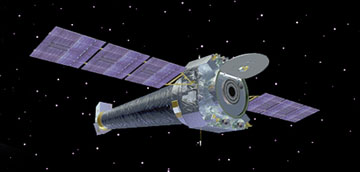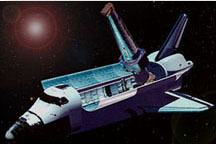
The Chandra X-ray Observatory Spacecraft (NGST)
How will observations of hot gas in clusters help to determine which theories of the origin and evolution of the universe are correct?
The giant galaxy clusters have been assembled through the collision and merger of smaller groups and clusters over billions of years. The speed at which this process occurs differs greatly, depending on the theory that is adopted. Observations of the numbers and sizes of clusters at great distances, corresponding to early times in the evolution of the universe, should rule out some of the competing theories for the origin and evolution of the universe.
Operations
The Chandra X-ray Observatory Center (CXC) is operated by the Smithsonian Astrophysical Observatory in Cambridge, Mass. The CXC, with a staff of over one hundred fifty people, will control science and flight operations of the Chandra X-ray Observatory for NASA at two facilities. The operation and control facility in Kendall Square is electronically linked to the science support facility at the Harvard-Smithsonian Center for Astrophysics.The CXC operations control group is responsible for directing the observatory's mission as it orbits Earth. The staff will interact with the observatory three times a day to acquire science and housekeeping information from its recorders. They will also send new instructions to the observatory as needed, and relay scientific information from the X-ray observatory to the CXC science support group.
The CXC science support group is an important resource for scientists and the public. They provide user support to researchers, including science data processing and a science data archive, and they work with NASA and the scientific community to inform the public of discoveries made by scientists using the observatory.
NASA and Partners
The Chandra X-ray Observatory program is managed by the Marshall Space Flight Center for the Office of Space Science, NASA Headquarters, Washington, D.C. TRW (now NGST) Space and Electronics Group of Redondo Beach, Calif., is the prime contractor and has assembled and tested the observatory for NASA. Using glass purchased from Schott Glaswerke, Mainz, Germany, the telescope's mirrors were built by Raytheon Optical Systems Inc., Danbury, Conn. The mirrors were coated by Optical Coating Laboratory, Inc., Santa Rosa, Calif., and assembled by Eastman Kodak Co., Rochester, N.Y.The CCD Imaging Spectrometer was developed by Pennsylvania State University, University Park, Pa., and the Massachusetts Institute of Technology (MIT), Cambridge. The High Resolution Camera was built by the Smithsonian Astrophysical Observatory. One diffraction grating was developed by MIT, the other by the Space Research Organization Netherlands, Utrecht, Netherlands, in collaboration with the Max Planck Institute, Garching, Germany. The Ball Aerospace & Technologies Corporation of Boulder, Colo., developed the aspect camera and the Science Instrument Module.

Portrayal of Space Shuttle Columbia deploying Chandra (NGST)
Top Ten Amazing Facts About Chandra
